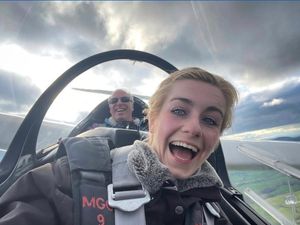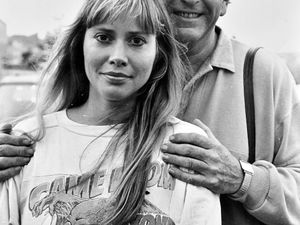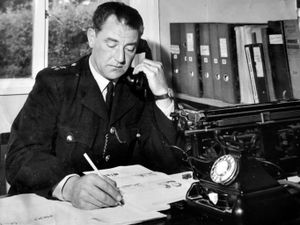Great Lives – Battle of Britain hero Eric Lock
Eighty years ago Shropshire hero Eric Lock, hailed by some modern historians as the RAF's greatest ace of the Battle of Britain, simply disappeared.
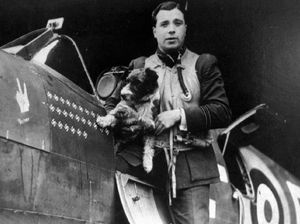
It is still just possible that one day the English Channel will give up a clue, maybe an identifiable remnant of a Spitfire brought up in a fishing net, or perhaps an overlooked eyewitness account of his final moments, but after so many decades of time and tides the chances are faint and it is probable that nobody will ever know what happened to him.
His body was never recovered for his family to mourn and he is listed on the Runnymede Memorial to the missing.
The much-decorated and battle-scarred warrior was only 22 when he died. He was one of the legendary "The Few" whose spectacular exploits had captured the imagination of the public during the dark days of 1940.
They marvelled at thrilling newspaper accounts of how this Shropshire farmer's son nicknamed "Sawn Off Lockie" by comrades as he was only 5ft 6ins had shot down 15 German aircraft in 19 days, including three in one afternoon.
When he went missing Lock had only recently returned to combat after many months of hospital treatment for serious wounds after being shot down in November 1940.
It was apparent to his family when he came home to Shropshire that he was a young man changed by his experiences. They harboured a hope that he would not be sent back into combat. But he was. Perhaps Lock, conscious of his status as a national hero, himself insisted on it – it's another thing nobody knows.
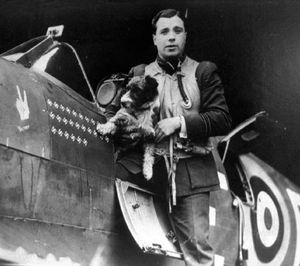
A letter written to his mother in June 1941 from RAF Hornchurch, where he was serving in 611 Squadron, is that of a tired man.
"About another month of this is about all I can stand," he wrote.
"We make on an average three trips a day, anything from 60 to 80 miles in (from) the coast, which believe (me) is not all fun.
"How is the harvest going on? You can see them when we are over France and then you realise how bloody stupid this war is.
"We had rather a bad time yesterday, two of my boys were shot down. The rest of us escaped by the skin of our teeth."
His letter concluded: "We are just about to go on our second raid now so I shall have to go. Please don't worry if anything happens to me because nine times out of ten our boys are prisoners of war. See you soon, Eric."
His final mission was on August 3, 1941, a low-level sweep in his Spitfire Vb over enemy-occupied France to shoot up targets of opportunity.
According to squadron records, he was last seen "streaking down a road... brassing off soldiers on bicycles and whooping over the R/T 'Ha-ha, look at the b******s running.'"
After that, nothing. Ever.
The squadron's operations records book said: "It seems a ruddy awful waste to lose so great a pilot on so trivial an expedition. It is anticipated that the German Press will make much of Lock's capture or death."
They didn't. They knew nothing either.
Flight Lieutenant Eric Lock had won the Distinguished Flying Cross, been awarded a Bar to his DFC – that is, another award of the same medal – and also the Distinguished Service Order.
During the period of the Battle of Britain he claimed 20 confirmed victories, making him, according to historians, the top-scoring RAF ace of the campaign.
With his love of fast cars, speed, and married to a Shrewsbury beauty queen, in the public's mind he was the very image of a brave, dashing and glamorous RAF hero.
Eric was born at Bomere Farm, Bayston Hill, the younger son of Charles Edward Lock, who farmed there and also carried on the nearby Sharpstone roadstone quarry.
Speaking in 1998 Eric's younger sister, Mrs Joan Statham, of Knockin Heath – she died in 2009 – said: “He liked speed, motorcycles and sports cars, and he bought a motorcycle which had been ridden in the TT. The rider had been killed and he bought it from the widow.
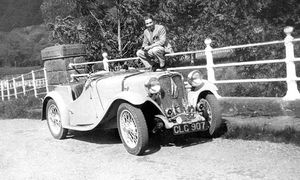
“Eric was a law unto himself. Once he scared us because he did not come home from school. We went to look for him. He was walking across the fields. He had been to Prees Heath and had a five bob flip with Alan Cobham’s flying circus. He wouldn’t have been more than about 12.
"And then he used to go to the Long Mynd and watch them gliding. I think he met Amy Johnson up there.”
By the time he had left school in 1933 his parents had left Bomere Farm and were farming Allfield, near Condover, on a lease while the family home was now a house called Eastington in Bayston Hill.
“He wanted to join the air force because he was mad on flying. My father wouldn’t sign the papers when he was 17. In those days a father farmer expected his sons to be farmers. Eric never went on the farm, although it says in some papers he did. He hated it. He would never have made a farmer.
“He joined the RAF Volunteer Reserve.”
By the outbreak of war he was a trained pilot, and joined the fray serving with 41 Squadron as the Battle of Britain reached its height.
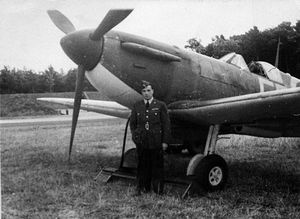
Mrs Statham said: “One of his pals had been shot down and the Germans filled his parachute with bullet holes. That is what spurred Eric to shoot down all those German planes.”
When he received news on December 9 that he had been awarded the Distinguished Service Order he was in hospital with gunshot wounds to his legs and arm after his Spitfire was shot up by a German fighter he never saw. He managed to crash land in a field.
As he lay injured he was amused to receive a white feather from a Red Indian chief, Whirling Thunder, to honour his bravery. No doubt the chief did not realise it was also the traditional sign of a coward.
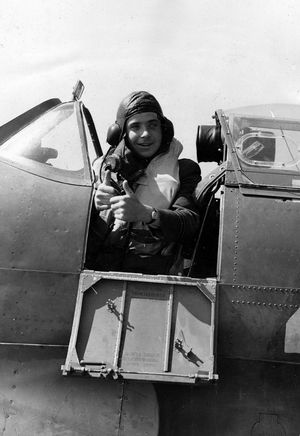
Lock’s injuries were to keep him in hospital for five months. He was able however to go to Buckingham Palace on April 1, 1941, to receive his three decorations from the King. It was said to be the first time in the war that three decorations had been conferred on one person at the same time.
During his periods at home he did not talk about his exploits, nor did his family press him to.
“He aged. He looked like somebody in his 40s, rather than 22. I think I had a premonition. The last time he went from home I stood on the lawn as his car went through the gate and just felt I wouldn’t see him again,” said Mrs Statham.

News that he was missing was phoned through to his wife, who was staying with them.
“He was shot down within 24 hours of Douglas Bader (in fact it was a few days later that Bader was downed). We were shell shocked at home and my mother and I spent days listening to Lord Haw-Haw to see if Eric’s name was mentioned. It wasn’t.”
Mrs Statham cherished mementos of her brother and had a treasured album full of memories, although sadly his flying log book has never come to light.
“Although it’s such a long time ago, I still find it all very emotional,” she said.
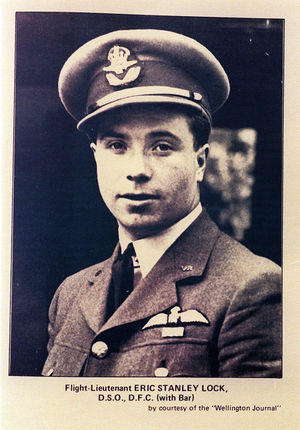
As to what happened to him on that fateful day in August 1941, the general assumption was that his aircraft was damaged by anti-aircraft fire and came down in the English Channel.
Then in the late 1990s research by renowned aviation author Dilip Sarkar seemed to have cracked the riddle, pointing to Lock being shot down into the sea by Luftwaffe ace Oberleutnant Johann Schmid in his Messerschmitt fighter.
However a biography of Lock in 2016 written by another aviation author, Steve Brew, in association with a relative of the Lock family, Mike Bradbury, dismissed that theory, as he found the times of Schmid's claim and Lock's loss were hours apart.
Dilip concurs with this finding, saying: "My conclusion, over 20 years ago, was drawn from information available at that time, which did not include the time of Schmid's claim.
"On August 3, 1941, Fighter Command lost one Spitfire – Lock. The only German claim was by Schmid, so it was not unreasonable to conclude that Lock had not been lost to ground fire, but had been shot down by a German fighter pilot.
"I have checked updated German combat claims, and I agree that Schmid could not have been responsible after all, given the time difference. We also have the benefit today of access to Lock's recently released casualty file, which was not in the public domain in 1999.
"What happened to Lock, however, we will never know, because there are no other known German claims on that day.
"His number 2 on that final flight did not see what happened, only receiving a last radio message to the effect that, having crossed the French coast over Boulogne, Lock was strafing German soldiers on bicycles.
"It is important to understand that a single rifle-calibre round could bring down a Spitfire. All it took was a hit in the coolant system and the engine would overheat and seize. It could be that a German soldier loosed off a few rounds and was unaware that he had actually fatally damaged, or even hit, the aircraft, which may explain the lack of a claim.
"The Spitfire, however, undoubtedly crashed in the sea, as no trace of either it or Lock has ever been found. Or it may just be that the German records are incomplete, which is not uncommon, given the quantity of records destroyed in 1945.
"Either way, it will remain yet another unresolved loss."
All agree that Lock came down in the English Channel. Even if Eric still had his damaged aircraft under control, ditching in a Spitfire was extremely dangerous, as they were notorious for sinking quickly, giving the pilot little time to escape.
Today Eric Lock is remembered in the name of a road in Bayston Hill, in memorial benches in Bayston Hill and outside Shrewsbury Castle, and by a plaque in Condover church and at Prestfelde School.
He left a 22-year-old widow, with whom he had enjoyed only a brief time together as a married couple.
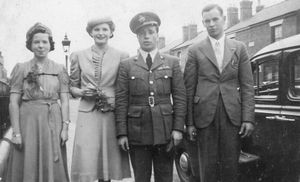
They had wed at St Julian's Church, Shrewsbury, on July 27, 1940, shortly before he was pitched into the maelstrom.
Canadian-born, she was before marriage Miss Margaret Meyers, known as Peggy, who had been the 1937 Miss Shrewsbury.
In July 1943 she married another RAF pilot, who was killed in a road crash while serving in Germany in 1953. She returned to Canada the following year with their two children.
She never remarried, and died in London, Ontario, in 1978, aged 58.
.................
ERIC LOCK FACTS
BORN: April 19, 1919, at Bomere Farm, Bayston Hill.
EDUCATION: Bayston Hill Elementary School; Clivedon School, Church Stretton; Shrewsbury High School For Boys, Swan Hill; St Alban's Preparatory School (now Prestfelde School), Shrewsbury. Left aged 14.
MARRIED: Peggy Meyers, of Percy Street, Shrewsbury, on July 27, 1940. No children.
RAF CAREER: Joined Royal Air Force Volunteer Reserve in February 1939. Posted to 41 Squadron in June 1940, first at RAF Catterick, Yorkshire, and then at RAF Hornchurch, near London. Slightly wounded in left leg September 5, 1940. Shot down November 8, 1940. Shot down and seriously wounded in left arm and both legs November 17, 1940. After recovery joined 611 Squadron at Hornchurch in June 1941.
AIR ACE: DSO citation of December 1940 credits Lock with 22 air victories up to then. Final number officially 24.
FATE: Missing on operations, August 3, 1941. Formally presumed dead July 1942.


